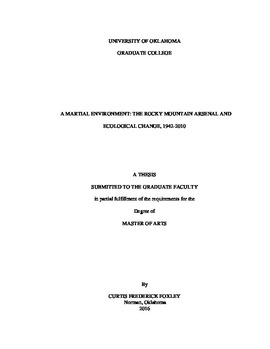| dc.contributor.advisor | Brosnan, Kathleen | |
| dc.contributor.author | Foxley, Curtis | |
| dc.date.accessioned | 2016-05-04T20:37:18Z | |
| dc.date.available | 2016-05-04T20:37:18Z | |
| dc.date.issued | 2016 | |
| dc.identifier.uri | https://hdl.handle.net/11244/34546 | |
| dc.description.abstract | This thesis examines the military-industrial complex and ecological change in the American West during and after the Cold War. By specifically examining one munitions factory—the Rocky Mountain Arsenal—this thesis demonstrates two things. First, it shows that the environmental consequences of warfare are not limited to combat areas. Second, it contends that the military-industrial complex continued to dominate the land after the Cold War ended. These arguments work together to demonstrate that the military-industrial complex dominated the Front Range’s environs through its weapons, waste, and its unilateral control over remediation. In both polluting the land and cleaning it up, the military-industrial complex demonstrated the extent of its control over the environment. | en_US |
| dc.language | en_US | en_US |
| dc.subject | Rocky Mountain Arsenal | en_US |
| dc.subject | Military-Industrial Complex | en_US |
| dc.subject | American West | en_US |
| dc.title | A Martial Environment: The Rocky Mountain Arsenal and Ecological Change, 1942-2010 | en_US |
| dc.contributor.committeeMember | Wrobel, David | |
| dc.contributor.committeeMember | Evans, Sterling | |
| dc.date.manuscript | 2016-04 | |
| dc.thesis.degree | Master of Arts | en_US |
| ou.group | College of Arts and Sciences::Department of History | en_US |
| shareok.nativefileaccess | restricted | en_US |
